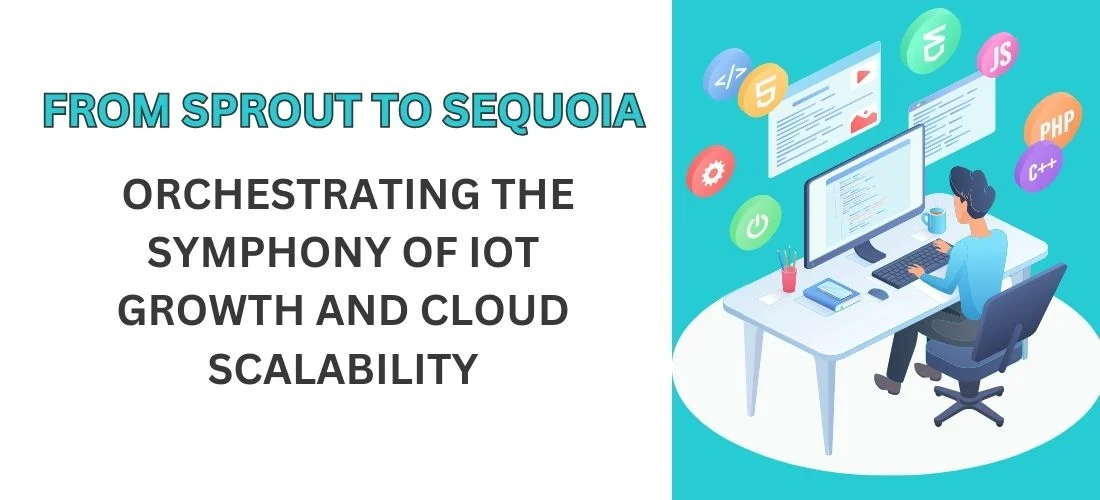From Sprout to Sequoia: Orchestrating the Symphony of IoT Growth and Cloud Scalability

As companies more and more flow their operations to the cloud, the ability to scale their resources fast and effectively has emerged as more important than ever before. Cloud scalability is the ability of a cloud infrastructure to boost or reduce dynamically in response to changing demands for computing resources, consisting of storage, processing power, or bandwidth.
In this article, we can speak about the cloud scalability from Sprout to Sequoia and how it plays a role in business operations. Knowledge cloud scalability is essential for ensuring foremost performance, cost-effectiveness, and flexibility in handling your IT infrastructure. So, allow’s dive in and explore the arena of cloud scalability!
From Sprout to Sequoia: Gain Innovation by Cloud Scalability
The cloud scalability benefits are driving cloud adoption for agencies huge and small as follows as
- Convenience: Often with just a few clicks, IT directors can without difficulty add more VMs which can be had immediately—and customized to the precise needs of a business enterprise. That saves precious time for the IT workforce. Instead of spending hours and days putting in bodily hardware, groups can be aware of different obligations.
- Flexibility and speed: As commercial enterprises need to trade and develop—such as sudden spikes in demand—cloud scalability allows IT to reply fast. Today, even smaller agencies have been admitted to high-powered resources that were once cost-prohibitive. No longer are businesses tied down by obsolete equipment—they can update structures and increase strength and garages without difficulty.
- Cost financial savings: Thanks to cloud scalability, businesses can avoid the upfront fees of buying expensive systems that might become outdated in a few years. Through cloud companies, they pay for the simplest things that they use and reduce waste.
- Disaster management: With scalable cloud computing, you can reduce restoration costs with the aid of eliminating the want for constructing and keeping secondary information facilities.
Also Read:- EveryPlate Login | Geekzilla Radio | Inflact Instagram Story Viewer
The Sapling: Maturation Through the Cloud Resources
Sapling is a source manipulation system used at Meta that emphasizes usability and scalability. Git and Mercurial customers will locate that the various fundamental principles are familiar — and that workflows like understanding your repository, working with stacks of commits, and getting better from errors are appreciably less complicated.
IoT and cloud computing embody a complex atmosphere of components and infrastructure, each gambling a vital function in permitting the seamless integration and operation of IoT systems with cloud-based services. The technology includes an advanced ecosystem of additives and infrastructure that work together to enable seamless verbal exchange, data processing, and storage in IoT deployments. Below, we mention the important thing factors concerned in this unique era:
Edge Devices
Edge devices form the frontline of IoT solutions, capturing facts from sensors, actuators, and other related devices inside the physical surroundings. These devices are generally geared up with processing abilities to perform initial record filtering, aggregation, and preprocessing obligations earlier than transmitting the data to the cloud.
Gateways
Gateways function as intermediaries between part devices and cloud servers, facilitating conversation, protocol translation, and records aggregation. They play a crucial position in bridging the distance between numerous IoT devices and cloud-based total packages, ensuring seamless connectivity and interoperability.
Cloud Servers
Cloud servers shape the backbone of IoT cloud computing, offering scalable and reliable infrastructure for storing, processing, and studying significant quantities of IoT facts. These servers host cloud-primarily based applications, databases, and analytics structures that enable agencies to derive actionable insights from IoT-generated data.
The Mighty Sequoia: Stability and Reliability in Full Bloom
Here are the various points that show scalability is a good approach.
- It’s easy: Raising or lowering potential generally entails only a few clicks from the IT administrator—no need to waste time, resources, or employees messing with physical hardware.
- It’s speedy: It’s all about fast scaling. Upgrading or downgrading your servers doesn’t take days or even weeks. These digital systems permit agencies to fast configure their architecture based on business needs.
- It’s cost-effective: Since cloud services are the most effective cost for resources that the business enterprise really makes use of, there may be no need to pay for unused resources or redundant or old systems.
- It’s perfect for catastrophe recovery: Scalability is also valuable for restoration operations. Thanks to cloud scalability, businesses can reduce catastrophe recuperation expenses by meeting the need to build and maintain backup data centers or spend finances on more data protection techniques.
- It’s reliable: Organizations may have peace of mind knowing they’ll see good performance, as scalable architecture will meet any surprising demand that will increase or decrease.
Challenges Along the Growth Trajectory: Navigating Complexity with Scalability

Cloud scalability functioning may also face some challenges before it grows. Let’s talk about these challenges.
- Diverse Data Formats and Sources: Different lines of business may also generate and consume data in numerous formats, starting from based databases to unstructured logs and streams.
- Varying Data Quality and Governance Requirements: Each area of enterprise may also have its own standards and protocols for data first-class, governance, and safety. Balancing the need for centralized management with the autonomy of enterprise devices requires careful making of plans and alignment.
- Scalability and Performance: As the amount and complexity of information keep growing, scalability and performance emerge as critical concerns. The centralized information platform should be able to accommodate increasing workloads and ensure the most desirable performance throughout various times.
Looking Ahead: Beyond Sequoias to Ever-Growing Horizons
As we replicate the metaphorical journey from sprout to sequoia in the context of IoT and cloud scalability, the horizon extends, promising new dimensions of connectivity and intelligence. The relationship between IoT and the cloud is dynamic, continually shaping the panorama of interconnected systems and applications.
Edge Computing’s Role in the Canopy
The next frontier entails the mixing of edge computing into the scalable cloud IoT paradigm. Edge computing brings processing strength in the direction of the supply of data, reducing latency and improving real-time results. This evolution mirrors the cover of the forest, in which the instantaneous needs of the surroundings are met with efficiency.
AI and Machine Learning as Fruits of Growth
As IoT platforms reach to the top, the result of the increase takes place in the form of artificial intelligence (AI) and machine-gaining knowledge. Scalable cloud infrastructure serves as the orchard in which these technologies thrive. AI algorithms, powered with the aid of substantial datasets stored and processed in the cloud, carry predictive analytics and adaptive functionalities to the leading edge, enriching the IoT ecosystem with unheard of abilities.
Conclusion
Building a centralized data platform which can gain the stress of business requires careful planning, collaboration, and a strategic combination of era and governance. By adopting a right architecture, imposing strong governance controls, and fostering a culture of collaboration, groups can empower commercial enterprise devices even as ensuring centralized governance and management. As organizations maintain to navigate the complexities of the data panorama, the potential to harness the power of data to drive innovation and gain strategic objectives may be a key differentiator in the current competitive market.




Leave a Comment